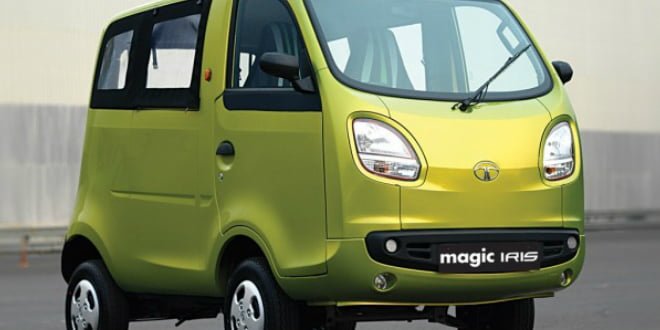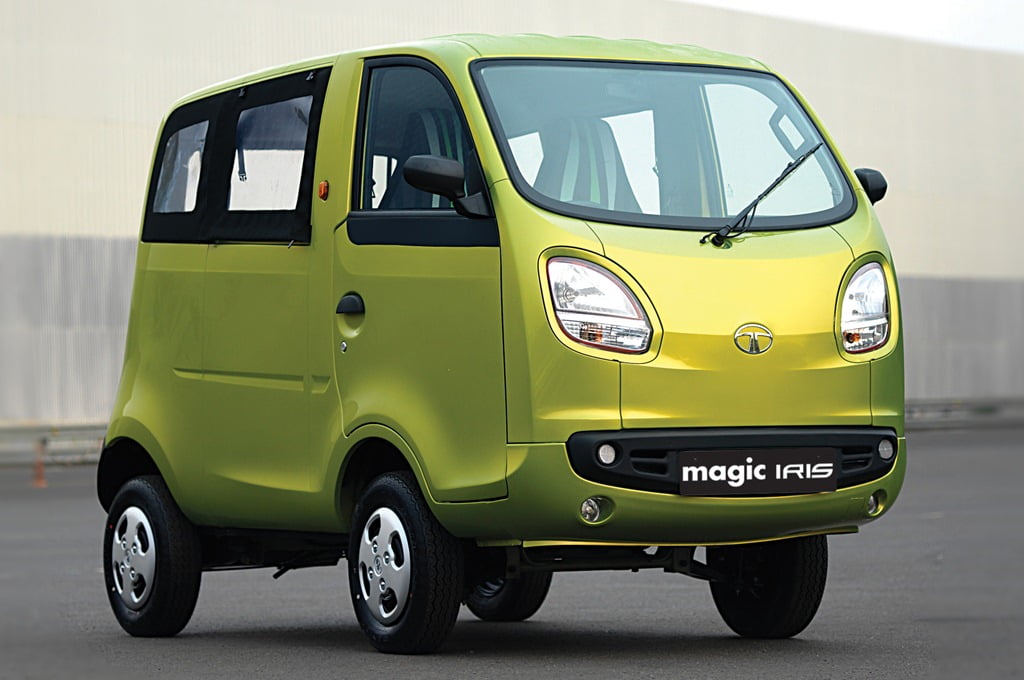The last-mile transport in many cities in India is the 3-wheeled autorickshaw. Compact, spacious for it’s size and economical this is a perfect runabout for our congested cities. There are some flaws with its design though, a three-wheeler is not very stable, this is dangerous especially in situations where the driver would have to take evasive maneuvers. The compactness also limits the passenger carrying capacity of the autorickshaw to 3 passengers at the most (there are bigger autorickshaws from Piaggio, but they loose out on compactness). Tata launched the Magic Iris at the 2010 Auto Expo to take on the autorickshaws from the likes of Bajaj, TVS and Piaggio. Now Tata is looking to expand the popularity of the Magic Iris by introducing a CNG variant. Today we have exclusive photos of the Tata Magic Iris CNG, which were shot in Delhi.
Updated on 25th April 2014
The transport department of New Delhi has given the go ahead to let the Tata Magic Iris ply on city roads. The Tata Magic Iris is a last-mile solution from the company that seeks to replace three-wheeled autorickshaws, offering better safety, comfort and space. The variant that would ply in Delhi will be the CNG variant which was spotted by us in October 2013 (read update below). Though slightly more expensive than Bajaj’s RE60 quadricycle, the Iris could have first mover advantage in the segment.
The Mumbai transport department is also considering an application submitted by the company to let the Iris ply inside the city limits.
The Iris will be available either as a 3-seater or a 5-seater. Would you rather travel in the Iris than an autorickshaw? Let us know in the comments section below.
Updated on 29th October 2013
Check the photos out below:
The Tata Magic Iris CNG will be offered with either 3+Driver or 4+Driver seating configuration, the 53-litre CNG tank will be placed under the passenger seat and leaving enough luggage space behind the passenger seat for small bags. Operators will have the option of adding a roof rack in case they need to carry more loads.
The 0.6-litre (611cc to be exact) single-cylinder engine will be carried over from the petrol variant of the Magic Iris, and will be BS-IV compaint. It will produce 13.2 BHP @ 3000 rpm and 39 Nm @ 1600-1800 rm (11 BHP @ 3000 rpm and 31 Nm @ 1600-1800 rpm for the petrol variant) which will be mated to a four-speed manual gearbox. The 53-litre CNG tank could hold up to 7 Kgs of CNG, and with a claimed (not ratified by ARAI) of 32 KMKG, the Magic Iris would have a range of about 220 Kms, enough for a city runabout.
The Tata magic Iris boasted of small dimensions (L x W x H in mm of 2960 x 1512 x 1800), adequate interior passenger space (wheelbase of 1650 mm), car-like driving comfort and riding comfort (McPherson struts at the front and coil-springs with semi-trailing arm at the rear). Now the Magic Iris CNG adds the cost savings of CNG to the mix. The availability of this variant will be limited, but will be helpful for cities like the national capital.
Though Tata has not revealed the price of the UV, it should cost marginally higher than the petrol variant. The petrol variant cost Rs. 2.10 Lakh, ex-showroom Delhi. The Bajaj RE 4S CNG costs about Rs. 1.15 Lakh, ex-showroom Mumbai.
What do you think of the Tata Magic Iris CNG? Will it be able to replace autorickshaws? Would you ride in them if you had a choice? Let us know in the comments.



